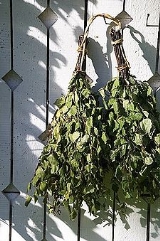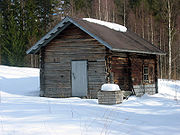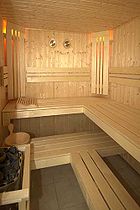
Finnish sauna
Encyclopedia


Culture of Finland
The culture of Finland combines indigenous heritage, as represented for example by the country's Uralic national language Finnish, and the sauna, with common Nordic and European culture. Because of its history and geographic location Finland has been influenced by the adjacent areas' various...
. There are five million inhabitants and over two million sauna
Sauna
A sauna is a small room or house designed as a place to experience dry or wet heat sessions, or an establishment with one or more of these and auxiliary facilities....
s in Finland
Finland
Finland , officially the Republic of Finland, is a Nordic country situated in the Fennoscandian region of Northern Europe. It is bordered by Sweden in the west, Norway in the north and Russia in the east, while Estonia lies to its south across the Gulf of Finland.Around 5.4 million people reside...
- an average of one per household. For Finnish people the sauna is a place to relax in with friends and family, and a place for physical and mental relaxation as well. Finns think of saunas not as a luxury, but as a necessity. Before the rise of public health care and nursery facilities, almost all Finnish mothers gave birth in saunas.
Origins of the sauna
The sauna in FinlandFinland
Finland , officially the Republic of Finland, is a Nordic country situated in the Fennoscandian region of Northern Europe. It is bordered by Sweden in the west, Norway in the north and Russia in the east, while Estonia lies to its south across the Gulf of Finland.Around 5.4 million people reside...
is such an old phenomenon that it is impossible to trace its roots. Bath houses were recorded in Europe during the same time period, but Finnish bathing habits were hardly documented until the 16th century. Because of the years of habitation and variant rule by Russia and Sweden, it is possible that the sauna custom evolved from them. It was during the Reformation in Scandinavia that the popularity of saunas expanded to other countries because the European bath houses were being destroyed. Hundreds of years ago, when bathing was something to be done only rarely or never at all, Finns were cleaning themselves in saunas at least once a week.
One reason the sauna culture has always flourished in Finland has been because of the versatility of the sauna. When people were moving the first thing they did was built a sauna. You could live in it, make food in the stove, take care of your personal hygiene and most importantly, give birth in an almost sterile environment. Unlike many other, more densely-populated places in Europe, availability of wood needed to build and warm the sauna has never been an issue. Another reason for its popularity is that in such a cold climate, the sauna allows people warmth for at least a short period of time. However, it is just as popular in the summer as in the winter.
Finnish sauna customs
Saunas are an integral part of the way of life in FinlandFinland
Finland , officially the Republic of Finland, is a Nordic country situated in the Fennoscandian region of Northern Europe. It is bordered by Sweden in the west, Norway in the north and Russia in the east, while Estonia lies to its south across the Gulf of Finland.Around 5.4 million people reside...
. They are found on the shores of Finland's numerous lakes, in private apartments, corporate headquarters, and even at the depth of 1400m in Pyhäsalmi Mine
Pyhäsalmi Mine
Pyhäsalmi Mine, the deepest metal mine in Europe is located at the Pyhäjärvi municipality in the south of Oulu province, Finland. The zinc and copper mine is owned by Inmet Mining, a Canadian mining corporation.- History :...
, and at the Parliament of Finland
Parliament of Finland
The Eduskunta , is the parliament of Finland. The unicameral parliament has 200 members and meets in the Parliament House in Helsinki. The latest election to the parliament took place on April 17, 2011.- Constitution :...
. The sauna is an important part of the national identity and those who have the opportunity usually take a sauna at least once a week. The traditional sauna day is Saturday.
The sauna tradition is so strong that even Finns abroad enjoy a good sauna, probably the reason the Finnish Church in Rotherhithe
Rotherhithe
Rotherhithe is a residential district in inner southeast London, England and part of the London Borough of Southwark. It is located on a peninsula on the south bank of the Thames, facing Wapping and the Isle of Dogs on the north bank, and is a part of the Docklands area...
, London, has its own sauna. Finnish soldiers on peacekeeping missions are famous for their saunas; even on the UNMEE mission in Eritrea
Eritrea
Eritrea , officially the State of Eritrea, is a country in the Horn of Africa. Eritrea derives it's name from the Greek word Erethria, meaning 'red land'. The capital is Asmara. It is bordered by Sudan in the west, Ethiopia in the south, and Djibouti in the southeast...
, a sauna was one of the first buildings to be erected. (A Second World War-era Finnish military field manual states that a rest of eight hours is all that is required for a battalion
Battalion
A battalion is a military unit of around 300–1,200 soldiers usually consisting of between two and seven companies and typically commanded by either a Lieutenant Colonel or a Colonel...
to build saunas, warm them and bathe in them.)
.jpg)
Finnic languages
The term Finnic languages often means the Baltic-Finnic languages, an undisputed branch of the Uralic languages. However, it is also commonly used to mean the Finno-Permic languages, a hypothetical intermediate branch that includes Baltic Finnic, or the more disputed Finno-Volgaic languages....
such as Karelian
Karelian
Karelian refers to something from or related to the region of Karelia, in present-day Russia and FInland*Karelians*Karelian language*Karelian foods* Karelian pasties* Karelian hot pot* Karelian Birch, a cultivar of Betula pendula...
löyly, Estonian
Estonian language
Estonian is the official language of Estonia, spoken by about 1.1 million people in Estonia and tens of thousands in various émigré communities...
leil, Votic leülü, Veps
Veps language
The Veps language , spoken by the Vepsians , belongs to the Finnic group of the Uralic languages...
l'öl and Livonian
Livonian language
Livonian belongs to the Finnic branch of the Uralic languages. It is a nearly extinct language, with one of its last native speakers having died in February 2009. It is closely related to Estonian...
löul. Its original meaning was 'spirit, breath, soul' and it is still seen in the Uralic languages
Uralic languages
The Uralic languages constitute a language family of some three dozen languages spoken by approximately 25 million people. The healthiest Uralic languages in terms of the number of native speakers are Hungarian, Finnish, Estonian, Mari and Udmurt...
, for example, Udmurt
Udmurt language
Udmurt is an Uralic language, part of the Permic subgroup, spoken by the Udmurt natives of the Russian constituent republic of Udmurtia, where it is coofficial with Russian. It is written in the Cyrillic script with five additional characters. Together with Komi and Komi-Permyak languages, it...
lul, Komi
Komi language
The Komi language is a Finno-Permic language spoken by the Komi peoples in the northeastern European part of Russia. Komi is one of the two members of the Permic subgroup of the Finno-Ugric branch...
lol, Mansi
Mansi language
The Mansi language is a language of the Mansi people. It is spoken in territories of Russia along the Ob River and its tributaries, including the Khanty-Mansi Autonomous Okrug and the Sverdlovsk Oblast...
läl 'life', Khanty
Khanty language
Khanty or Xanty language, also known previously as the Ostyak language, is a language of the Khant peoples. It is spoken in Khanty-Mansi and Yamalo-Nenets Autonomous okrugs, as well as in Aleksandrovsky and Kargosoksky districts of Tomsk Oblast in Russia...
lil and Hungarian
Hungarian language
Hungarian is a Uralic language, part of the Ugric group. With some 14 million speakers, it is one of the most widely spoken non-Indo-European languages in Europe....
lélek. Occasionally one uses leafy, fragrant boughs of silver birch
Silver Birch
Betula pendula is a widespread European birch, though in southern Europe it is only found at higher altitudes. Its range extends into southwest Asia in the mountains of northern Turkey and the Caucasus...
called vihta in West Finland and vasta in East Finland to gently beat oneself. This has a relaxing effect on the muscles and also helps in calming the effects of mosquito bites. When the heat begins to feel uncomfortable it is customary to jump into a lake, sea, or a swimming pool, or to have a shower. In the winter rolling in the snow or even swimming in a hole cut in the ice, an avanto, is sometimes used as a substitute. Then one usually sits down in the dressing room or the porch of the sauna to enjoy a sausage, along with beer or soft drink
Soft drink
A soft drink is a non-alcoholic beverage that typically contains water , a sweetener, and a flavoring agent...
s.
After cooling one goes back to the hot room and begins the cycle again. The number and duration of cycles varies from person to person according to personal preference. Usually one takes at least two or three cycles, lasting between 30 minutes to two hours. In Finland
Finland
Finland , officially the Republic of Finland, is a Nordic country situated in the Fennoscandian region of Northern Europe. It is bordered by Sweden in the west, Norway in the north and Russia in the east, while Estonia lies to its south across the Gulf of Finland.Around 5.4 million people reside...
's numerous summer cottages bathing might go on well into the night. This is especially true in the summer when there is virtually no darkness. For many Finns, the sauna is almost a sacred place. It is usually considered especially rude to swear in sauna, even in company that does not usually shy on swearing. Thorough washing will end the session of sauna. Conversation is relaxed and arguments and controversial topics are avoided. It is also rare to use titles or other honorifics in the sauna. In Finnish folklore, the sauna is the home of the sauna-elf
Elf
An elf is a being of Germanic mythology. The elves were originally thought of as a race of divine beings endowed with magical powers, which they use both for the benefit and the injury of mankind...
, a spirit of the sauna (saunatonttu in Finnish).
Sometimes men and women go to the sauna together, sometimes not. For someone brought up in Finland, the rules are instinctive but they are difficult to put into words. Depending on the size, composition, relationships, and the age structure of the group three basic patterns can emerge: Everyone can go to the sauna at the same time, men and women may take sauna separately, or each family can go to sauna separately. Mixed saunas with non-family members are most common with younger adults, and are quite rare for older people or on more formal occasions. It is common for teenagers to stop going to sauna with their parents at some point.
In the sauna it is a faux pas
Faux pas
A faux pas is a violation of accepted social norms . Faux pas vary widely from culture to culture, and what is considered good manners in one culture can be considered a faux pas in another...
to wear clothing in the hot room, although it is acceptable to sit on a small towel or pefletti
Pefletti
In Finland, a pefletti is a simple device used in a sauna. It is a sheet of paper, cardboard, cloth, foam rubber or other soft material that is placed on the sauna bench and then sat on. Its purpose is to maintain sanitary conditions in a sauna with a wide user base by preventing genital contact...
, a disposable tissue designed to endure heat and humidity (it can be mandatory in a public sauna, such as at a public swimming pool). While cooling off it is common to wrap a towel around your body. Though mixed saunas are quite common, for a typical Finn the sauna is, with few exceptions, a non-sexual place. In Finland
Finland
Finland , officially the Republic of Finland, is a Nordic country situated in the Fennoscandian region of Northern Europe. It is bordered by Sweden in the west, Norway in the north and Russia in the east, while Estonia lies to its south across the Gulf of Finland.Around 5.4 million people reside...
"sauna" means only a sauna, not a brothel, sex club, or such. In public saunas one also sees signs prohibiting the wearing of swimming suits in the hot room. In some indoor swimming pools chlorine is added to the water for hygiene reasons. If swimwear used in such water is brought to the hot room, the chlorine will vaporize and cause breathing problems for people with asthma
Asthma
Asthma is the common chronic inflammatory disease of the airways characterized by variable and recurring symptoms, reversible airflow obstruction, and bronchospasm. Symptoms include wheezing, coughing, chest tightness, and shortness of breath...
or allergies
Allergy
An Allergy is a hypersensitivity disorder of the immune system. Allergic reactions occur when a person's immune system reacts to normally harmless substances in the environment. A substance that causes a reaction is called an allergen. These reactions are acquired, predictable, and rapid...
. The oldest still active public sauna can be found in the Pispala
Pispala
Pispala is a city district 2.5 km from the centre of Tampere, Finland. It is located on the northern slope of Pispalanharju, the highest esker in Finland....
district of Tampere
Tampere
Tampere is a city in southern Finland. It is the most populous inland city in any of the Nordic countries. The city has a population of , growing to approximately 300,000 people in the conurbation and over 340,000 in the metropolitan area. Tampere is the third most-populous municipality in...
. Rajaportin sauna
Rajaportin sauna
Rajaportin sauna is Finland's oldest working public sauna. The sauna was founded in 1906 in Pispala in Tampere.Rajaportin Sauna is owned by Tampere city and run by the Pispalan saunayhdistys ry.-External links:* AND here are the media reports...
began its operation 1906 and is currently owned by the City of Tampere. It is however run by the local Pispala Sauna Association
Foreign visitors to Finland often get invited into the sauna. This may even happen after business negotiations and other such events. On these occasions it may be acceptable to refuse, although it may not impress one's Finnish hosts. Such an invitation in a business setting may indicate that the negotiations have gone well and a joint business effort is anticipated. In private homes or summer residences the sauna is usually warmed to honour the guest and refusal may be more difficult. However, Finns will not typically be offended by declining the sauna.
Types of sauna
Many different types of sauna can be found in Finland. They can be classified either by the sauna building itself or by what kind of stove it uses.The main division of saunas is between once warmed and continuously warmed stoves. All smoke saunas are once warmed, but there are also other type of ovens that are once warmed.
Once warmed stoves have larger amount of stones that are warmed up before the bathing. This can be done by burning wood, with or without chimney, oil or natural gas. Continuously warmed stoves have lower amount of stones that are heated during the bathing. All electric saunas belong to this category, but the warming can be done burning wood, oil or natural gas.

